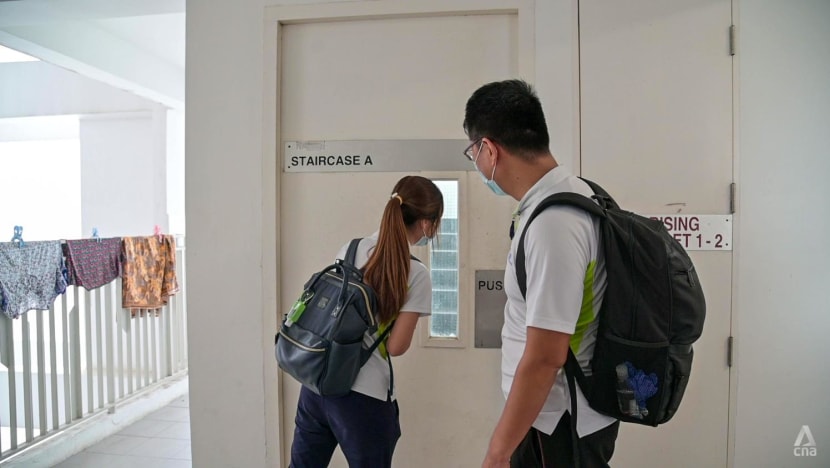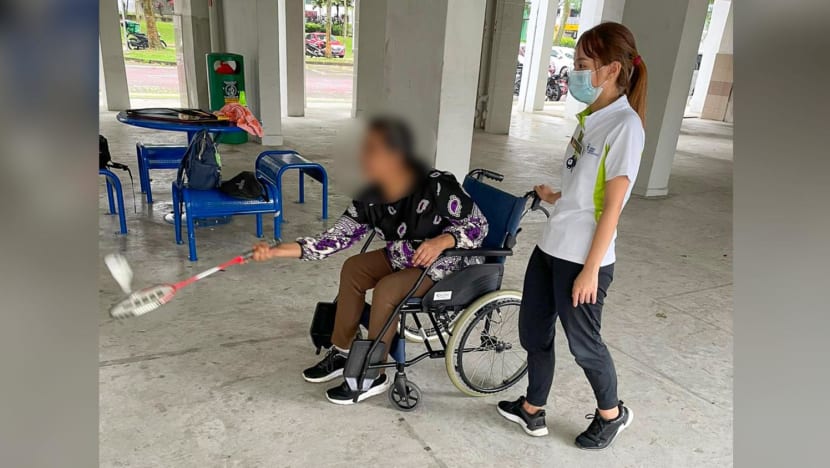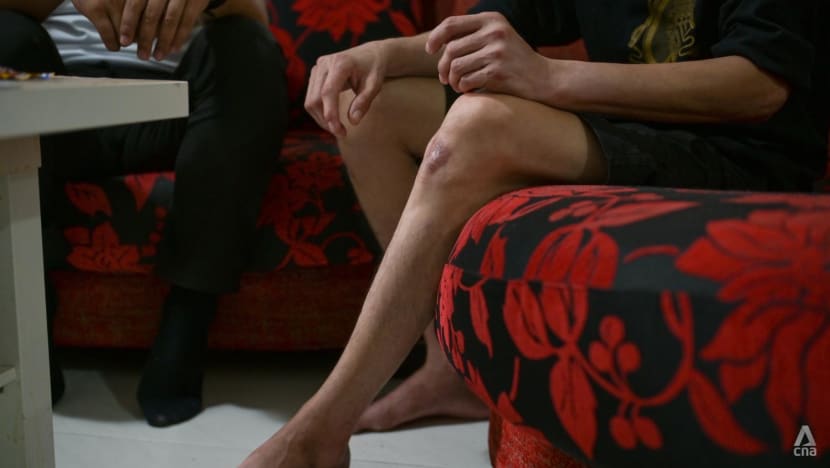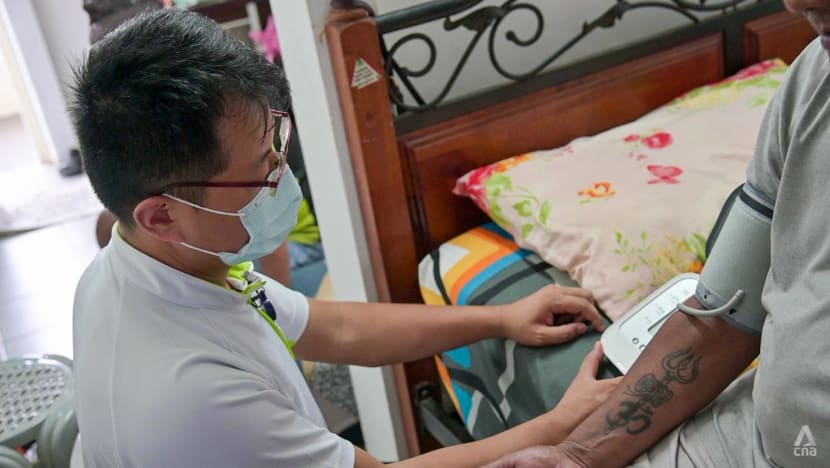Alcoholics kept returning to A&E in this hospital. So a medical team chose to help them at home
Is going cold turkey the way to tackle alcoholism? For some patients, Khoo Teck Puat Hospital advocates a different approach by, for example, encouraging them to reduce their intake rather than harp on abstinence.

Senior community nurse Zhang Ruyi (left) and medical social worker Jovina Cheng visit patients weekly in the first two months of the Alcohol-Related Frequent Attenders programme. (Photo: Christy Yip/CNA)
- The KTPH team helps patients achieve their personal goals, rather than focusing on their addiction.
- One patient used to drink nine cans of beer a day. The team helped her drop to three — through a badminton game with her family.
- Visits to the emergency department from these patients have dropped by more than half since the programme began in 2020.
SINGAPORE: Emergency physician Desmond Mao has encountered many a drunkard. At work, the protocol was to treat their physical ailments and send them home with a referral to an addictions specialist.
Outside of work, he used to give them a wide berth. Like most people, perhaps, he “didn’t want any trouble”, he said.
But these days, his nonchalance has turned to curiosity. It was propelled by a nagging problem in Khoo Teck Puat Hospital’s (KTPH)’s emergency department, where he has been practising for some 12 years: The same patients with alcohol misuse kept returning.
These patients could come in with chest or leg pains — symptoms of overdrinking — or could be brought in by paramedics because they were on the streets, flat-out drunk. Sometimes they were “rowdy” and caused the department “a bit of grief”.
After discharge, some would “come back straight away,” said Mao. “Some of them even come back two to three times a day.”
In 2017, he was tasked to look into the issue.
Indeed, a study published in the Australasian Professional Society on Alcohol and other Drugs found that between 2007 and 2016, the rate of alcohol-related emergency department visits across Singapore’s hospitals had increased by 62.4 per cent.
Older men contributed a disproportionate burden to this increase. At KTPH, they tended to be males aged 50 to 70 from a lower socio-economic background.
The hospital’s approach had to change, and Mao began to see these patients with different eyes. As a result, there is now a new way of helping them.

UNDERSTANDING THEM BETTER
It might be easy to believe that alcohol addiction is due to a person’s lack of willpower, but Mao said this is a misconception. Patients sometimes fall into alcoholism for deeper reasons.
He recalled talking to patients at about 2 to 3 a.m., the time they would usually sober up. Why did they come to the emergency department, and how did alcohol come into it, he asked.
A pattern began to emerge: Many of them had a history of exposure to alcohol from a young age; many experienced “deep hurts” at home, and for better or for worse, alcohol was a coping mechanism.
Understanding this is “in no way absolving (the patients) from falling into an alcohol trap”, said Mao. “But they have this natural susceptibility to alcohol that we need to recognise.”
And one of the issues relating to their treatment is how to get them to turn up for appointments.
Although doctors have done their part in referring patients to the Institute of Mental Health’s National Addictions Management Service (Nams) or to in-house addiction specialists, many patients do not follow it through.
Mao attributes this to brain atrophy — alcohol causing the brain to shrink. “The patient’s level of capability decreases to some extent,” he said. For example, taking a cab or a bus to a treatment centre may appear too difficult.
Hence, rather than harping on a detoxification programme, a team of doctors, community nurses and medical social workers led by him tried a harm reduction approach.
In 2020, KTPH launched the Alcohol-Related Frequent Attenders (Arfa) programme. Over six months, the team met patients in their homes or their favourite haunts to bring counselling and basic medical care to them.

The aim: To help patients find the intrinsic motivation to quit, while encouraging them to reduce their alcohol intake. The programme has also rolled out in Tan Tock Seng Hospital and Singapore General Hospital.
Is it worth taking the trouble with these patients? Even with the unanswered calls, no-show patients or their drunken stupors when home visits are made, the team says yes.
“I not only understand them better, but I also gained compassion for them,” said Mao.
PREPARED FOR REJECTIONS
The work begins at the emergency department itself. When a patient has been identified as coming in for the umpteenth time for issues related to overdrinking, the Arfa team make their first contact.
“We don’t wait for patients to appear on our doorstep (and) say that ‘I’m ready for change,’” said Mao.
We offer treatment to them assertively.”
If the patients are agreeable, a community nurse and medical social worker will manage their case over the next six months.
The nurse tends to their general health and alcohol-related symptoms, and the social worker to their psychosocial issues, linking them up with social services if needed.
While patients may be receptive to help at first, multiple rejections thereafter are par for the course. That is why the first two months of the programme are dedicated to building a rapport with the patients through weekly visits.
This reporter got a taste of rejection when a female patient in her 40s appeared drowsy during a scheduled visit and did not wish to speak to the team.
It was 1pm, as was agreed because the patient, Sarah (not her real name), normally woke up late, medical social worker Jovina Cheng said. But Sarah just had her lunch and was feeling too bloated to function.
A wasted trip then? Cheng shrugged aside the suggestion — the team had gained more information, and they planned to visit Sarah at noon the next time round.
After years of walking the ground, Cheng and senior community nurse Zhang Ruyi have got a plan for every bump in the road.
When a patient is not at home at the agreed time or refuses to pick up the phone, they would scout the nearby coffee shop and ask neighbours if they would know where the patient usually hangs out.

There are times patients forget ever meeting the Arfa team or what had been arranged on the last visit.
So the team pays “impromptu visits”, said Zhang. They appear at their patient’s usual hideout, claiming that they happened to be in the area and wanted to say hi.
“We want to create another level of impression that this nurse (and) social worker come and visit him often,” he said. “Once he’s ready, at least he’ll call us.”
Some patients do not have a registered contact number or place of residence as they are homeless, added Zhang, who would stick a Post-it where they usually sleep in the hope of getting a call.
“Surprisingly, some really call me back,” he said.
GETTING THROUGH TO PATIENTS
More often than not, the team’s persistence pays off. The key, said Zhang, is to not focus on the addiction lest the patients feel judged or isolated.
“They might feel like they’re being monitored, rather than us wanting to help them,” he said. “They’re not looking for people to give them a lecture.”
Sometimes he might ask his patients about their favourite drink to get them more comfortable with him. Slowly they would start to open up.
“Then they’re ready to share,” he said. Share their relationship problems, family conflicts, job issues or financial difficulties — the root cause of their addiction.
WATCH: The hospital that helps alcoholics stay out of the A&E (10:58)
Many patients refuse help because they tend to “self-stigmatise”, said Cheng.
“A lot will tell you, ‘You’re a normal person. I’m not a normal person,’” she said. “They already think they’re very special people who can’t be helped. But I’ll say, ‘No lah, it’s not like that.’”
To her, these patients are “just normal people who have their own problems”. Unlike some others who, say, jog to deal with stress, they were exposed to a “maladaptive” way of coping, which is to use substances, she said.
The team learned that Sarah, for example, had troubled relationships when she was younger and now with her own children. Drinking was “the fastest way” to forget, Cheng said. “The brain is already very used to thinking that.”
Last April, when the team first met the woman, who is in her 40s, she had all but relinquished hope of quitting alcohol.
“When I needed someone (before), there was no one. Then when I become worse, people come for what?” she told CNA Insider.
“When you’ve been doing something that you always did, then suddenly people ask you to cut (down), you (would be) happy or not?”
But Cheng and Zhang, who had visited her relentlessly, moved her. “Irritating … but they try to understand me,” she said.

It was never more evident than the time they bought badminton rackets and shuttlecocks and took Sarah and two of her children to the void deck to play.
The team had found out from their chats that Sarah used to love sports, and she yearned to spend more time with her children, if only her addiction did not stand in her way.
She could hardly stand for long and used a wheelchair to get about. She also spent most of her day sleeping, as alcohol disrupted her sleep pattern.
That badminton game was a turning point: A month after first meeting the Arfa team, she agreed to try reducing her daily alcohol intake from nine cans of beer to six. By the third month, she was down to three and was also willing to visit Nams.
This long counselling process, known as motivational interviewing, allows patients to understand that “their (drinking) behaviour doesn’t (go) together with their personal goals”, said Zhang.
So instead of telling them to stop drinking, Zhang and Cheng start by asking the patients what their personal goals are (or, if they do not know, by guiding them in the thought process).
If reducing their alcohol intake is in line with what they would like to achieve, they would be more motivated to work on it, said Cheng.

COLD TURKEY NOT FOR ALL
The Arfa team does not fixate on abstinence as some patients are not ready for that level of lifestyle change.
Most of the patients drink about 100 units of alcohol — equivalent to 10 bottles of wine — a week; to suddenly drink nothing at all can be unfathomable. “But what they’ll consider is reducing their alcohol usage,” said Mao.
Harm reduction is a “pragmatic” approach and a pace they can “tolerate”. And going slow allows the patients to see the fruits of their labours.
“When they’re more sober, they’re able to function better, they’re able to get other things in their life sorted out, they can control their medical diseases better,” said Mao. “That leads to a virtuous cycle.”
It could also be dangerous for some patients to go cold turkey. They could experience withdrawal symptoms such as retching, restlessness and anxiety and would need monitoring and medical support.
Take, for example, Michael (not his real name), who is in his late 40s and has turned up at the emergency department an “embarrassing” number of times for alcohol-related accidents, by his own admission.
For most of his life, he needed at least three cans of beer to start the day; at his worst, he could drink up to 24 cans in a day. Without alcohol, his hands would tremble, so much so that he won’t be able to lift a cup to drink.

The Arfa team encouraged him to cut his drinking step by step, from 12 cans a day to six cans and so on. It’s more than a year since the intervention, and it’s now two cans, or fewer, a day.
“It used to be that the alcohol controlled my body. Now I can control the alcohol,” he said.
MEASURING SUCCESS
Abstinence is still the end goal. But so long as the patients cut as much alcohol as possible in the time spent in the programme, the team considers it a win, as the patient’s health and function would have improved.
After the six-month mark, the team passes the baton to other community partners, like family service centres.
While most of the patients do improve their addiction management before then, Mao acknowledged that some of them will not or get worse, depending on how complicated their case is.
Since 2020, 36 patients have enrolled in KTPH’s Arfa programme. The hospital has seen, on average, a 40 per cent reduction in alcohol intake among the patients.
The average drop in the number of accident and emergency (A&E) visits per patient is 57 per cent as at last November.
Among the 76 patients enrolled across the three participating hospitals, an estimated 64 per cent have reduced their visits by 25 per cent. Seven patients have made it all the way to the end of a Nams detoxification programme.

Patient well-being aside, it is important to “rationalise” the use of emergency resources in hospital, given how swamped the department and paramedics can be, said Mao.
Most of the Arfa patients can be better managed in the community, he added. This also improves the working environment for front-line staff, who are sometimes not spared “some level of abuse” from intoxicated patients.
The KTPH team see the programme results as an encouraging sign that they are moving in the right direction.
Indeed, working in the programme has shown Zhang “the power of movement”. Better to be “moving slowly” than running in place, he noted. “(The patients) need encouragement, they need motivation, they need time.”
“Where there’s life, there’s hope” is the team’s mantra, Mao shared. “As long as there’s life, people can change.”
And what gets his hopes up is the work of colleagues such as Zhang and Cheng, and the great lengths they go to “to tell the patients that ‘you’re worth it’.”




















